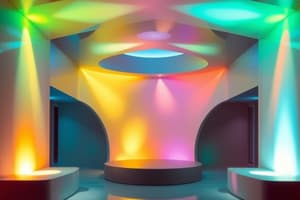Podcast
Questions and Answers
What are the standard units used in physical science to measure light output?
What are the standard units used in physical science to measure light output?
Lumens
Which wavelengths are the human eye more sensitive to?
Which wavelengths are the human eye more sensitive to?
- Short wavelengths
- Certain wavelengths of visible light (correct)
- Long wavelengths
- Mid wavelengths
What is spectral luminous efficiency (Vλ)?
What is spectral luminous efficiency (Vλ)?
A method to measure power emitted in Watts over narrow wavebands.
What is luminous flux and what unit is it measured in?
What is luminous flux and what unit is it measured in?
What is luminous efficacy?
What is luminous efficacy?
A typical incandescent lamp may have an efficacy of around __ lm/W.
A typical incandescent lamp may have an efficacy of around __ lm/W.
How do you calculate the efficacy for a lamp that requires a ballast?
How do you calculate the efficacy for a lamp that requires a ballast?
A solid angle is measured in __.
A solid angle is measured in __.
What is the unit of luminous intensity?
What is the unit of luminous intensity?
Flashcards are hidden until you start studying
Study Notes
Lighting Metrics and Calculations
- Understanding photometric measurements and units is crucial for effective lighting design.
- Standard power units like Watts do not adequately represent light output; for example, a 100W fluorescent lamp can produce seven times the light of a 100W filament lamp.
Spectral Eye Sensitivity
- Spectral luminous efficiency (Vλ) quantifies power output across various wavelengths, indicating human eye sensitivity to visible light.
- Different wavelengths affect scotopic (night vision) and photopic (daylight vision) performance.
Luminous Flux
- Luminous Flux (Φ) is measured in lumens (lm), representing the total light output from a lamp.
- The relationship between luminous flux, power, and spectral luminous efficiency is integral for calculating a lamp's light output.
Luminous Efficacy
- Luminous efficacy (η) measures energy efficiency in lumens per watt (lm/W).
- Efficacy varies among lamp types; typical incandescent lamps have about 10 lm/W, while modern T8 lamps can reach 100 lm/W.
- To calculate total wattage input correctly, include ballast power in addition to the lamp power to assess efficacy accurately.
Solid Angle
- Solid angle measures three-dimensional angles, represented in steradians, akin to radians in two dimensions.
- A 1-steradian solid angle corresponds to a surface area on a sphere equal to the square of the sphere's radius.
Luminous Intensity
- Luminous intensity (I) represents the amount of light emitted in a specific direction per second, measured in candelas (cd).
- It is defined as the luminous flux (Φ) emitted in a specified direction, emphasizing the directional characteristics of light sources.
Studying That Suits You
Use AI to generate personalized quizzes and flashcards to suit your learning preferences.




